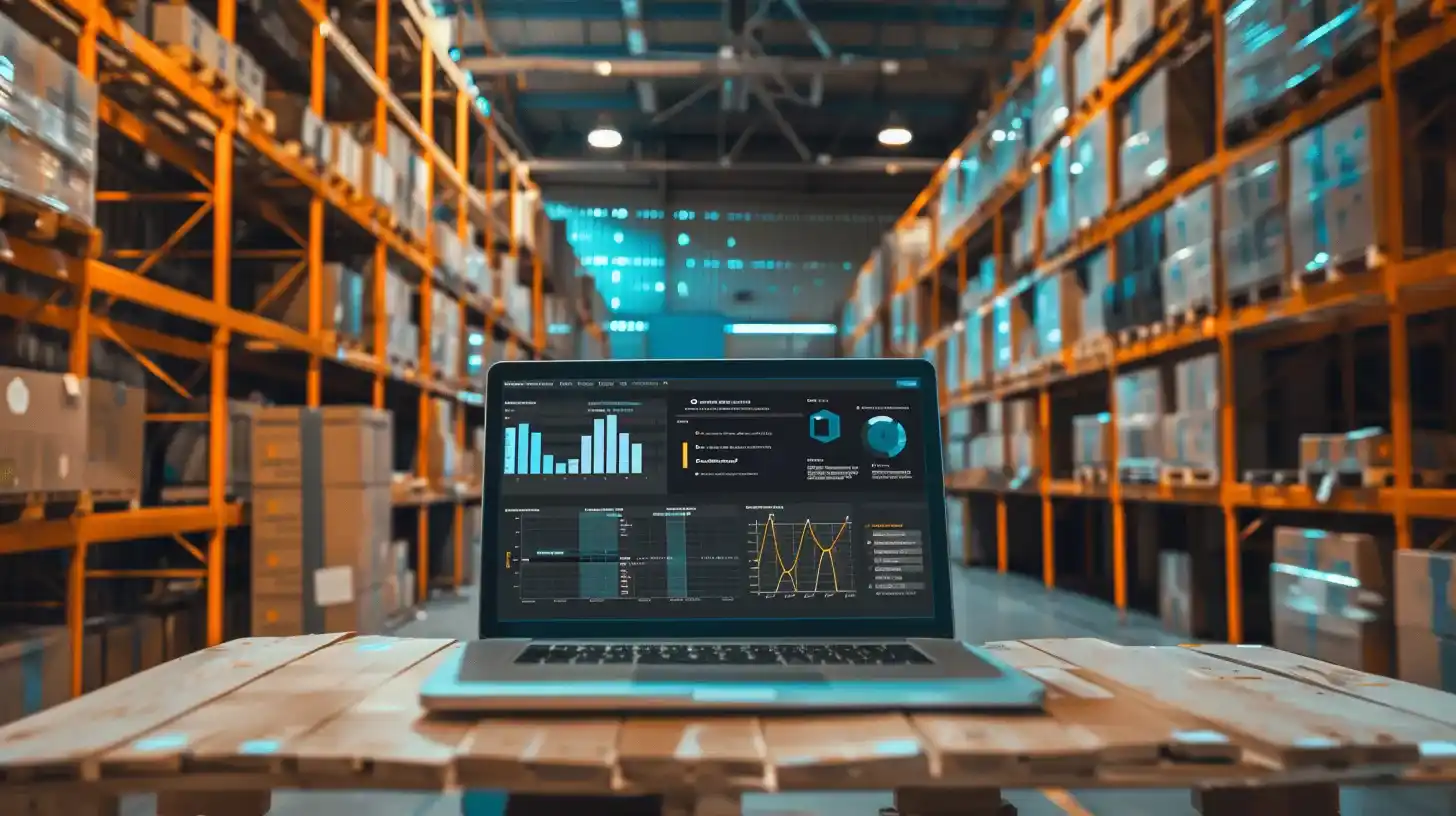Table of Contents
In today’s rapidly evolving business landscape, effective management of inventory through ERP inventory management systems has become essential. These systems streamline operations by integrating inventory, finance, planning, logistics, and operations on a single platform, utilizing real-time data to orchestrate complex inventory processes across an organization.
Moreover, ERP in inventory management assists in calculating order quantities, ensuring that businesses replenish their stock in a timely and cost-effective manner, which is critical for maintaining operational efficiency and meeting customer demands.
As businesses look to optimize their inventory management processes, selecting the right ERP software for inventory management that offers comprehensive features of ERP inventory management, including supply chain management, demand planning, and real-time inventory visibility, becomes paramount. Implementing an ERP inventory management system not only eradicates data silos by integrating processes across departments but also mobilizes data for better decision-making.
Such an approach ensures that businesses keep an optimal amount of inventory on hand, preventing the accumulation of surplus, and thereby significantly enhancing operational agility and profitability.
Understanding ERP Inventory Management
ERP inventory management stands as a comprehensive approach, streamlining business operations by integrating various functions—inventory, finance, operations, planning, and logistics—on a singular platform. This integration ensures that each function while operating as an independent piece of software, contributes to a unified, efficient system. The core components of ERP systems include:
- Automation and Data Management: Automating repetitive tasks, managing data efficiently, and providing insightful reporting.
- Supply Chain Management (SCM): Enhancing visibility and control over the supply chain.
- Accounting and Financial Management: Streamlining financial operations and reporting.
- Customer Relationship Management (CRM): Improving customer interactions and satisfaction.
Key features of ERP inventory management systems that significantly benefit businesses include:

- Real-time Tracking: Offers automatic updates to align current inventory data with actual stock levels, reducing data redundancy and preventing stockouts.
- Automated Thresholds: Utilizes historical sales data and seasonal trends to set realistic inventory thresholds, minimizing excess inventory and associated costs.
- Production and Expiry Tracking: Keeps tabs on manufacturing and expiry dates to avoid stock becoming dead or unprofitable.
- Inventory Turnover Tracking: Assists in tracking and optimizing inventory turnover rates, crucial for making informed decisions on pricing, manufacturing, and inventory purchases.
By leveraging ERP inventory management, businesses can optimize their inventory levels, ensuring they have just the right amount of stock on hand. This optimization not only improves efficiency but also enhances the entire supply chain’s visibility, including warehouses, stores, and goods in transit.
Moreover, ERP systems facilitate better decision-making by recommending optimal purchase and transfer orders and improving manufacturing processes through efficient product planning, raw material sourcing, and production monitoring.
Key Benefits of ERP Inventory Management
ERP inventory management stands as a pivotal component in streamlining operations, enhancing efficiency, and driving cost-effectiveness across various business processes. Here are the key benefits broken down:
- Increased Efficiency and Cost-Effectiveness
- Automation of tasks such as updating pricing and generating purchase orders reduces human error.
- Real-time tracking and automated workflows enhance demand forecasting accuracy, leading to optimal stock levels.
- Enhanced Data Security and Decision Making
- Cloud-based ERP software offers superior data security over manual or on-premises solutions.
- Access to accurate historical data and customizable reporting aids in making informed decisions about inventory management and forecasting.
- Streamlined Operations Across Departments
- ERP systems enable better product identification through SKU, serial numbers, and lot numbers.
- Integration of logistics, operations, finance, and inventory in a singular system minimizes errors and boosts efficiency.
The adoption of ERP in inventory management not only simplifies replenishment orders and achieves supply chain transparency but also facilitates surplus inventory management, tracks inventory turnover, and ultimately improves customer satisfaction through efficient service delivery and product cost management.
Selecting the Right ERP System

Selecting the right ERP system for your business involves a comprehensive approach that takes into account various factors to ensure a perfect fit. Here’s a guide to streamline your selection process:
- Compatibility and Accessibility
- Ensure ERP compatibility with major frameworks like JAX, PyTorch, TensorFlow, and access through platforms such as Colab, Kaggle notebooks, and Hugging Face.
- Evaluate device and cloud platform compatibility, ensuring seamless integration and operation.
- Vendor Selection and System Requirements
- Research potential ERP vendors, focusing on pricing, features, and support services.
- Develop a list of business requirements categorized into ‘must-have’, ‘nice to have’, and ‘not mandatory’.
- Confirm ERP supports essential functions like sales orders, multiple currencies, and tax systems.
- Determine integration capabilities with existing systems and evaluate the ease of customization.
- Cost, Support, and Strategic Fit
- Estimate the total cost of ownership and ROI, ensuring alignment with business strategy.
- Plan for ongoing support and training, ensuring the ERP system remains up-to-date and employees are proficient.
- Seek references within your industry and consider the vendor’s experience and financial stability.
By carefully assessing these factors, you can select an ERP system that not only meets your current needs but also supports your business growth and evolution.
Implementing ERP Inventory Management
Implementing ERP inventory management is a structured process that requires meticulous planning and execution to ensure it aligns with your business objectives and enhances your inventory management processes. Here’s a step-by-step guide to navigating through this crucial phase:
- Needs Assessment and System Design:
- Identify Pain Points: Understand the challenges within your current inventory management system.
- Define Objectives: Clearly outline what you aim to achieve with the ERP system.
- Customization: Tailor the ERP system to meet your unique inventory management needs.
- Preparation and Deployment:
- Data Migration: Prepare and clean existing data for migration to ensure accuracy and integrity.
- Training and Testing: Conduct comprehensive training sessions for users and perform thorough testing to confirm the system’s functionality.
- Phased Roll-Out: Implement the ERP system in stages to monitor performance and make necessary adjustments.
- Post-Implementation and Continuous Improvement:
- Support: Provide ongoing support to address any issues promptly.
- Optimization: Continually assess and optimize the ERP system to align with evolving business needs.
- Multiple Testing Rounds: Conduct several rounds of testing to ensure the robustness and reliability of the ERP system.
By following these steps, you can effectively implement ERP inventory management, ensuring a seamless transition and maximizing the benefits of your new system.
Best Practices for ERP Inventory Management

To master ERP inventory management, adopting best practices is crucial for streamlining operations and enhancing efficiency. Here are key approaches to optimize your inventory management processes:
- Forecasting and Planning:
- Create a forecasting model: Utilize tools to analyze historical trends and predict optimal product quantities.
- Plan for peak season: Incorporate peak season demands into your forecasts to ensure readiness.
- Establish Inventory KPIs: Monitor performance with clear milestones for inventory management.
- Operational Efficiency:
- Optimize warehouse operations: Use technology to enhance storage and automate inventory counts.
- Build realistic lead times: Account for manufacturing to transit times for better customer satisfaction.
- Minimize unused capital: Implement just-in-time production to balance supply and demand effectively.
- Inventory Optimization:
- Categorize inventory with ABC analysis: Prioritize products based on their importance.
- Use cycle counting: Improve accuracy and reduce safety stock by ensuring system counts match physical stock.
- Carry safety stock: Guard against unexpected demand surges and forecast inaccuracies.
Additionally, fostering strong relationships with vendors and mimicking physical processes in your ERP system can significantly improve inventory management. Balancing data entry and engaging experts for SKU design review are also among the best practices that can lead to successful ERP inventory management.
Conclusion
Throughout this article, we have explored the transformative power of ERP inventory management systems in streamlining and optimizing inventory processes. From eradicating data silos and mobilizing data for better decision-making to ensuring optimal stock levels and enhancing operational agility, ERP systems present a strategic solution for businesses aiming to maintain efficiency and profitability in today’s competitive landscape.
The journey from understanding the core components and benefits of ERP inventory management to selecting and implementing the right ERP system underscores the importance of a meticulous approach tailored to an organization’s unique needs.
In essence, mastering ERP inventory management is not merely about adopting new technology but about embracing a strategic framework that enhances every facet of inventory management. By incorporating best practices, from forecasting and planning to operational efficiency and inventory optimization, businesses can unlock a new level of precision and effectiveness.
As organizations look forward to further streamlining their operations and driving growth, the insights offered in this guide serve as a foundational step towards leveraging ERP inventory management systems to their full potential, marking a significant stride in the evolution of inventory management practices.
FAQs
Q: What are the essential steps involved in inventory management?
A: Inventory management should encompass five critical steps: planning and forecasting, purchasing and ordering, receiving and storing as well as packing, tracking inventory, and finally, fulfilling orders. These steps are fundamental for the success of any business that handles inventory.
Q: How does an ERP system aid in inventory management?
A: ERP systems assist in managing inventory by tracking and reporting on shortages and surpluses, as well as important metrics such as the average turnover rate and the cost of goods sold. They monitor the movement of products and shipments, which enables companies to enhance inventory efficiency and increase customer satisfaction through the analysis of vital inventory metrics.
Q: What strategies can be employed to learn an ERP system effectively?
A: To effectively learn an ERP system, one should first understand its benefits and choose the most suitable training method. Practicing with real-life scenarios, seeking help and support, and continuously learning and updating knowledge are also crucial. Additionally, enjoying the learning process can significantly contribute to mastering ERP.
Q: What are the key steps to achieving accurate inventory management?
A: Accurate inventory management can be achieved through four main methods: just-in-time management (JIT), materials requirement planning (MRP), economic order quantity (EOQ), and calculating days sales of inventory (DSI). These methods aim to optimize inventory levels, preventing both excess and insufficient stock.